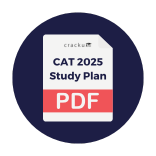CAT Number Systems Formula PDF is the cornerstone of quantitative aptitude for any competitive exam. Knowing about the Number system basics for the CAT exam can boost one's score significantly. Understanding how to apply number system formulas is essential, not just memorising them.
This blog provides a complete overview of important CAT number system formulas and their significance. We have also included tips to solve difficult Number system questions for CAT. One can find link to download Cracku's CAT Number System Formulas PDF for Free.
Download CAT Number System Formula Pdf
Importance of CAT Number Systems Formula PDF
A well-organized CAT Number Systems Formula PDF is essential for CAT aspirants. Here's why:
- Quick Reference: Formulas are the building blocks of problem-solving. A PDF provides a handy reference sheet for rapid recall during exams.
- Concept Reinforcement: Regular revision of formulas strengthens your conceptual understanding of the topic.
- Time Management: Knowing formulas can significantly reduce calculation time, allowing you to attempt more questions.
- Shortcut Discovery: Many formulas offer alternative approaches to problem-solving, acting as valuable shortcuts.
Complete CAT Quant Formula List
Preparing for the CAT exam means you need to understand different math topics, and we’re here to help. We’ve gathered all the important CAT quant formulas in one place to make your study easier. Below is a table with links to download PDFs for topics like Progressions, Interest, Geometry, and more.
Number System Shortcuts for CAT
While formulas are essential, shortcuts can provide a competitive edge. Some common shortcuts include:
- Divisibility Rules: Quickly determine if a number is divisible by specific digits (e.g., 2, 3, 4, 5, etc.).
- HCF and LCM: Employ efficient methods to calculate the highest common factor and lowest common multiple.
- Prime Numbers: Utilize properties of prime numbers to simplify calculations.
- Remainder Theorem: Apply the theorem to efficiently find remainders in division problems.
Weightage of Number Systems in CAT
Number Systems typically carry a weightage of around 5-10% in the CAT Quantitative Aptitude section. Around 2-4 questions come from Number Systems every year. The major areas covered in Number Systems formula PDF are Basics of Numbers, Divisibility rules, factors, HCF/LCM, Finding out last digit, Numbers of trailing zeroes, etc.
Table: Approximate Weightage of Topics in CAT Quantitative Aptitude
| Topic | Approximate Weightage |
|---|---|
| Arithmetic | 40-45% |
| Algebra | 25-30% |
| Geometry | 15-20% |
| Number Systems | 5-10% |
| Modern Math | 5-10% |
CAT Number Systems Questions Trend
| Year | Weightage |
| 2023 | 7 |
| 2022 | 4 |
| 2021 | 2 |
| 2020 | 9 |
| 2019 | 5 |
Looking for hardcopy handbook?
Order below. Delivery charges are on us :)

Tips to Ace CAT Number Systems Problems
- Conceptual Clarity: Begin by understanding the underlying concepts rather than merely memorizing formulas.
- Practice Regularly: Consistent problem-solving is key to building proficiency.
- Focus on Basics: Master the fundamentals like divisibility rules, HCF, LCM, prime numbers, and remainder theorems.
- Learn from Mistakes: Analyze incorrect answers to identify knowledge gaps and improve problem-solving strategies.
- Time Management: Practice solving questions within given time limits to enhance speed and accuracy.
Conclusion
A strong foundation in Number Systems is essential for success in the CAT exam. By effectively utilizing a CAT Number Systems Formula PDF, practicing regularly, and mastering shortcuts, you can significantly enhance your problem-solving abilities and improve your overall score. Remember, consistent effort and a strategic approach are key to conquering this crucial topic.
Ready to bell the CAT? Download Cracku's FREE Number Systems Formula PDF to supercharge your CAT preparation. Sign up for Cracku and get access to expert-curated study material, mock tests, and more!






















